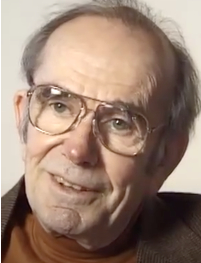On this date in 1929, entomologist Thomas Eisner was born in Berlin to artist Margarete Heil-Eisner and Hans Eisner, a chemist with Jewish roots. The family moved to Barcelona to escape the Nazis, then to Uruguay during the Spanish Civil War and finally to the U.S. in 1947.
Eisner enrolled at Champlain College in Plattsburgh, N.Y., transferring to Harvard two years later. There he took his first entomology course and roomed with E.O. Wilson, later renowned as a biologist for his ant studies. As graduate students, they got a $200 grant (when gas was 20 cents a gallon) and took a two-month road trip to collect insect specimens.
Eisner joined the faculty at Cornell University in Ithaca, N.Y., after earning a Harvard doctorate in 1955. He would remain at Cornell for his entire professional career. He’d become a naturalized U.S. citizen in 1952, the same year he married Maria Lobell, later a research associate of biology at Cornell. They would be married for 58 years and have three daughters: Yvonne, Vivian and Christina.
“Dr. Eisner realized early in his career that in addition to sounds and visual cues like colored markings and elaborate dances, insects often communicate through chemical signals. Dr. Eisner and Jerrold Meinwald, a Cornell chemistry professor, are considered the fathers of a field now known as chemical ecology.” (New York Times, March 30, 2011)
Some of his most famous work was conducted on the bombardier beetle, which creates a chemical reaction within its body to shoot a boiling, noxious liquid from a nozzle in its abdomen to ward off predators. Ironically, creationists would use the beetle as evidence of so-called intelligent design, a claim Eisner strenuously refuted. When humorist Dave Barry read about Eisner’s research, he said if he should ever be elected president, he would name him his Entomologist General: “An engraving of a bombardier beetle emitting a blast from his butt would look great on a coin.” (“Krulwich Wonders,” NPR, April 6, 2011)
Natalie Angier, Pulitzer Prize-winning science columnist, called Eisner “a Darwinist down to his very ribosomes.” According to Angier, he “had a notoriously mordant sense of humor” and once said, “I may not believe in God, but I don’t ring doorbells saying I’m a Seventh-day Atheist.” Asked his opinion of assisted suicide, he said he hadn’t decided yet because he was “still working on assisted homicide.” (New York Times, April 4, 2011)
Eisner was a panelist at Cornell’s three-day celebration in February 2006 of Darwin’s birthday. It was hosted at the Museum of the Earth by Provost Biddy Martin, soon to be named chancellor at the University of Wisconsin-Madison. Eisner told the assembled audience of about 100, “To me, it is immensely satisfying to know that we humans are not the product of special creation, that we came into being by the same gradual evolutionary process that gave rise to the other living forms on Earth.” Scientists must engage, Eisner said, in “uncompromising political involvement” to guard “constitutionality” by separating religion from the teaching of science. (Cornell Chronicle, Feb. 14, 2006)
He was instrumental in founding Cornell’s Department of Neurobiology and Behavior in 1964. He and Wilson and Richard O’Brien co-authored the popular college textbook “Life on Earth” in 1973. Throughout his life, he was published widely, academically and otherwise.
“Imagine beetles ejecting defensive sprays as hot as boiling water; female moths holding their mates for ransom; caterpillars disguising themselves as flowers by fastening petals to their bodies; termites emitting a viscous glue to rally fellow soldiers,” Harvard University Press mused in 2003 about Eisner’s “For Love of Insects.” Two years later, with his wife and Melody Siegel, he published “Secret Weapons: Defenses of Insects, Spiders, Scorpions, and Other Many-Legged Creatures.”
The National Academy of Sciences in 2008 recognized his “pathbreaking studies of the myriad ways that organisms utilize chemistry to mediate ecological interactions and providing a foundation for the field of chemical ecology” and included a $25,000 award. He garnered numerous other honors and honorary degrees.
Eisner was afflicted for over a decade with Parkinson’s disease, which gradually led to his inability to play the piano in his office and at home, which when younger he thought about playing professionally. He was also a talented photographer. Complications from Parkinson’s led to his death at age 81 at home in Ithaca. (D. 2011)


